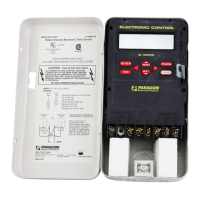I
Have you checked the kiln for loose connections?
UNPLUG kiln/disconnect the power. Open the kiln’s switch box. Look for loose, corroded or discolored element
connectors and wire terminals. They will appear dark, greenish-turquoise and sometimes white. Cut off
over-heated wire terminals and crimp on new terminals. Remove the damaged element connector and inspect the
element end. If the element is damaged, replace the element. Otherwise sand the element end and install a new ele
-
ment connector.
I
Does the kiln have a power connection fuse box?
Kiln Power Connection
High Amperage Fuse Test
This fuse box is used only on high amperage kilns such as the Viking-24 & 28. The fuse box usually
contains six fuses. If a fuse blows, one relay will stop working. To test fuses, disconnect the power.
Place the leads of an ohmeter on each end of a fuse. (It is okay to leave the fuse you are testing in the fuse holder.) An
OPEN reading on a digital meter, or no-needle-movement of an analog meter, indicates a blown fuse. If fuses are in
-
serted upside-down, they will be loose and will blow.
Some elements do not fire.
I
What is the kiln model? Which element is not firing?
See your wiring diagram. Perform the element glow test:
Element Glow Test
1 The kiln should be empty. Close the lid or door.
2 In Ramp-Hold, fire at a rate of 9999 to 500°F/260°C. While the kiln is firing, study your kiln’s wir-
ing diagram. It will show which elements are wired to each relay.
3 At around 400°F/204°C, carefully lift the lid or open the door slightly until you can see the glowing elements.
Use a protective glove. Keep your face well away from the firing chamber. Do not reach inside the chamber. DO NOT
TOUCH THE ELEMENTS WITH ANYTHING. Lift the lid for only a moment, then close.
The center elements in most 7, 8, 10 and 12 sided kilns will not glow brightly, but there should be a faint redness. It
is easier to see the elements with room lights turned off. Some kilns take 40 minutes before the elements glow red.
Test result: All the elements for one relay remain dark.
If all the elements on the same relay are out, try connecting that bank of elements to a different relay. If the elements
fire on a different relay, unplug kiln and open the switch box. Look for a disconnected wire between controller, relay
and elements. If wiring is okay, replace the relay the elements were originally connected to.
If the bank of elements do not fire after connecting to a different relay, test elements with an ohmmeter. See page 5.
Test result: Some, but not all, elements for one relay glow.
If more than one element is wired to the relay, the dark element is probably burned out. The problem is not the relay.
Open the switch box. Look for a disconnected wire between the relay and element. If wiring is okay, test the ele
-
ments with an ohmmeter (see page 5).
I
Does the kiln have an infinite control switch wired to the elements that do not fire?
If the relay and elements have tested okay, replace the switch.
8
Test a high amperage fuse with an ohmmeter.
You can test the fuse without removing it from
the fuse holder.
High amperage fuses are usually located inside
the fuse box or junction box on the kiln.
Disconnect
Power before
removing
switch cover.
The fuse must be aligned as shown above. If it is
inserted upside-down, it will blow.

